Super Early Deadline
30 November 2025
Judging
Date
24 & 25 March 2026
Winners Announcement
22 April 2026
30 November 2025
24 & 25 March 2026
22 April 2026

California’s Central Valley is famed for its abundant citrus groves, a landscape that shaped Rick Allen's life from an early age. Today, Allen channels that vibrant essence into Ginagain, his craft gin brand rooted in the flavors of California’s citrus but crafted in the heart of the UK. The result is a unique, fruit-forward gin that remains grounded in the traditions of a classic London Dry, with the brightness of California oranges and the peppery warmth of cubeb berries. In this interview, Allen shares how he blends his Californian heritage with British distilling prowess, crafting gins that pay homage to his roots while appealing to gin connoisseurs worldwide.
California, like Spain, is renowned for citrus and produces over ¾ of the fruit and nuts in the US, so we knew that it only made sense to include it in our gin. I grew up driving through the citrus farms of California’s Central Valley and Central Coast around Monterey Bay. Just like you see row after row of vineyards driving through the areas of France, we see row after row of fruit trees and nut trees. We’d like to extend people’s summer a little with a taste of California.
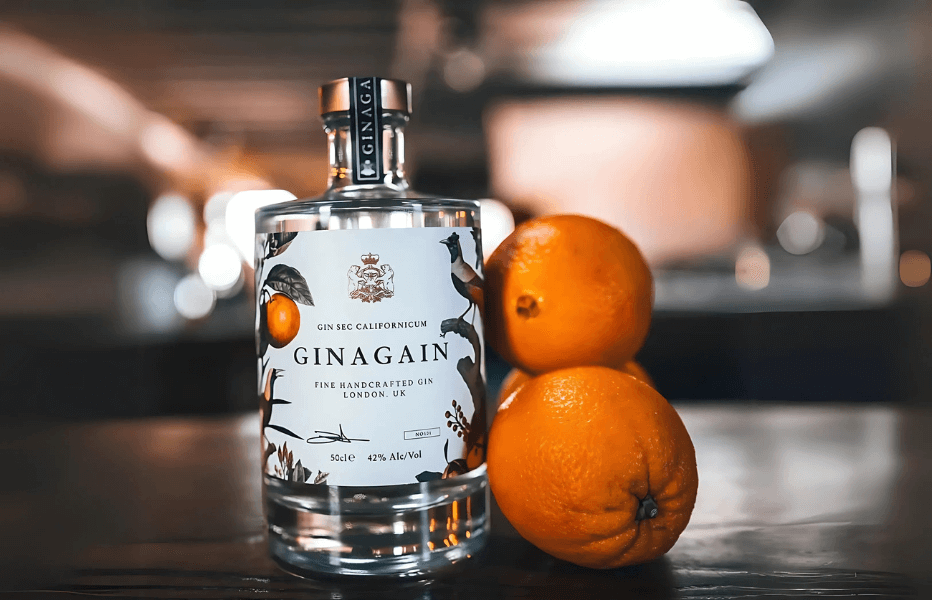
Image: Ginagain.
We wanted to create a gin that was more balanced than just an “orange-flavoured gin” with less sweetness and a bit more zing from the citrus. The cubeb berry peppers add a hint of tartness. We tried the recipe with black and pink peppercorns and didn’t quite achieve the taste profile we were after. So we moved on to other peppers and we found that by using Cubeb we can get the spice of black peppers without the bite.
It is definitely a crowded market, but I think what sets us apart is the use of quality organic California citrus peel and being a fruit-focused gin without being a flavored gin.
Ultimately we want to bring a touch of Californian culture that is usually overlooked. The Central Valley extends from north of San Francisco almost all the way down to Los Angeles. It has an amazing array of agriculture, people, and stories. It is fed by the snow melt of the Sierra Nevadas and can get extremely hot in summer, up to 40 degrees, which comes on the heels of a fairly short winter and some of the prettiest weeks of apple and citrus blossoms throughout the spring.
The reason for partnering with a UK distillery is twofold: The UK has an extremely strong, educated gin culture, and if we can make it here we can make it anywhere. In the US it’s not as common to order a G&T at a bar, and typically the tonic will come out of a gun. In the UK there is a much larger selection of tonics, and more gin variety as well. On the one hand, there is a lot more competition in the UK, but on the other, there is so much more gin appreciation.
The second reason is that it is legally much easier to create a company in the UK when you’re talking about spirits. In the US you need “Formula” (recipe) approval, after that you get “COLA” (Certificate of Label Approval), as well as the rest of the permits for distilling, warehousing, and selling. On top of that, you still need to jump through the hoops of being able to ship the alcohol across state lines. True there are UK licenses and permissions we needed to acquire, but compared to trying to get it off the ground, the UK was much easier.
Since we currently live in California it’s not too hard for the brand-personality to have quite a bit of the West Coast present since we live it day to day. We are planning on moving to England early next year which will pull us away from living the California lifestyle, but since we have so much history, family, and friends in California there is no way it will ever leave us. And of course, our use of California citrus will be ongoing.
[[relatedPurchasesItems-63]]
First off, there is an inherent challenge in being a two-person, self-funded, inexperienced company.
A big challenge was of course getting the recipe down. It took us 66 tries to get our first gin (Ginagain 01) to a point where we thought it was worthy of investing in a commercial distillation. Then there is the “grandma’s cookies” conundrum - even if you use her recipe, nothing is quite like the taste of grandma’s cookies - especially at scale. The same with gin - how do we translate the recipe from using the ingredients available here in a small, concept still to a recipe using botanicals sourced in the UK (except for the citrus) and on much larger stills that are configured differently?
The challenges we are facing now are even larger - now that we got the “product” of the gin down, we are now focused on the “business” of gin (bottle and label costs, distribution, etc) as well as the “marketing” of gin. A mediocre gin with great marketing can be much more successful than a great gin with mediocre marketing.
We both have marketing backgrounds which has been a huge benefit as far as being able to play with an initial marketing positioning early on. Since we can design our own marketing assets and know the ins and outs of advertising that side of the business is slightly easier. We still go back and forth over what our branding should be and we want to make sure people recognise us from a quick glance either at a bar or out and about.
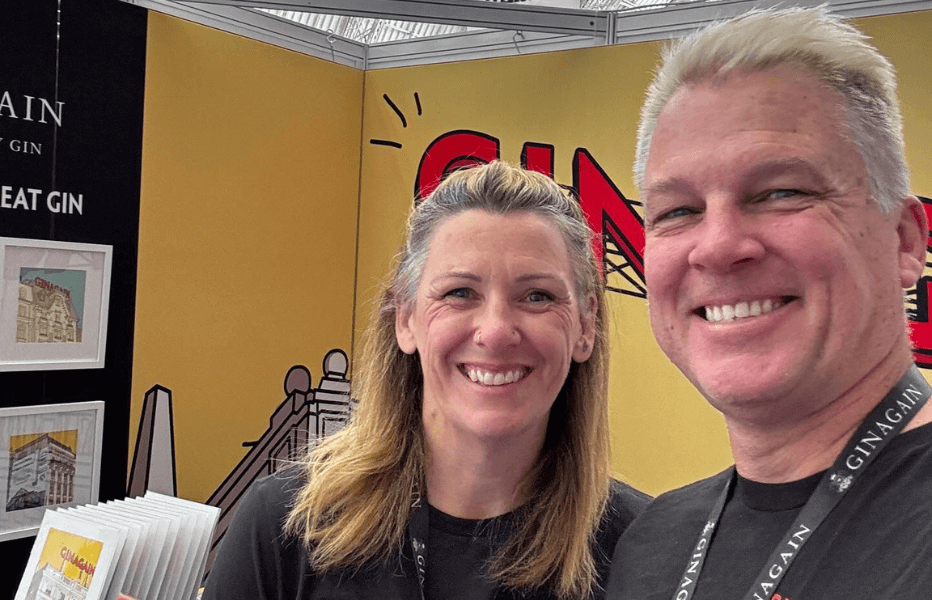
Image: Stephanie Pratt and Rick Allen, founders of Ginagain.
For our second gin, we wanted to continue with organic California citrus. Stephanie wanted to see if she could replicate a white grapefruit and basil martini she once had years ago. White grapefruit is more subtle than pink grapefruit and brings a crisp citrus note that is complemented by the basil. Similar to our first gin, we experimented with peppers to add a kick at the end, but they tended to overpower the grapefruit and basil. Ginger and basil tend to complement each other in a lot of food dishes and we decided it might work with the grapefruit as well.
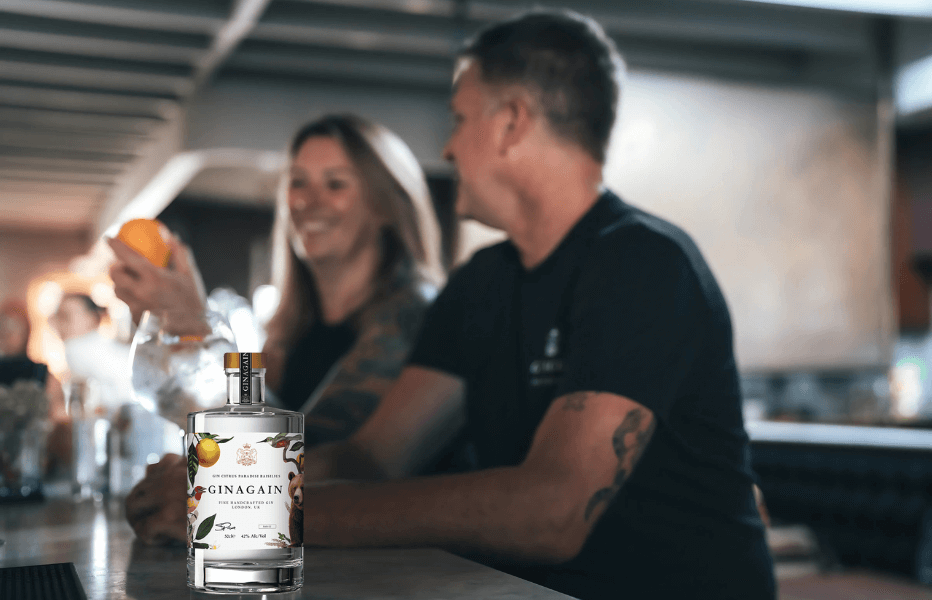
Image: Stephanie Pratt with Rick Allen with "Ginagain 2".
I would say go for it! There are so many inspirational quotes out there, but my favorite as it pertains to distilling your own craft gin is “You miss 100% of the shots you don’t take”. My words of advice would be - to be patient, be persistent, learn from your mistakes, ask for help from others (the gin community has been extremely helpful), and not get frustrated. I know this sounds counterintuitive, but I would say DON’T set realistic goals BUT create realistic expectations. 100% go set out to be the next Hendrick’s, but understand that a lot of the big gins out there are part of much larger companies with deeper pockets and wider skill sets.
We know that sweeter fruit and pink gins have been popular for a while but we don’t want to compete against them, rather we think Ginagain No. 1 is a perfect transition gin from those sweeter profiles to a contemporary London Dry.
We want to create gins that we enjoy, and since neither of us really like the flavoured gins we didn’t want to go in that direction. Business-wise, I think if we were to focus on a trend we would probably shoot for a low or no-alcohol gin or even a seltzer. Personally, I think if you want a flavored gin you should start with a quality gin base and add your flavors just as you would a cocktail.
When building any business it is a learning curve when it comes to your impact on the environment. It is always tempting to go for a cheaper mass-produced option, especially when it comes to something like citrus, which needs to be processed before we can import it into the UK. We work with a small biodynamic, organic orchard and they only pick the fruit when we order it. We then dry the peel. This means we have a lighter, smaller product that has a smaller carbon footprint when shipping than if we were to work with fresh peel.
Our distillery partner is a member of Greenspark and is always looking for ways to reduce their carbon footprint, and we are reviewing our bottle design to make it lighter and easier to pack as well as what it is actually produced from. As we learn this business and all of the different touch points we look for ways that we can do better.
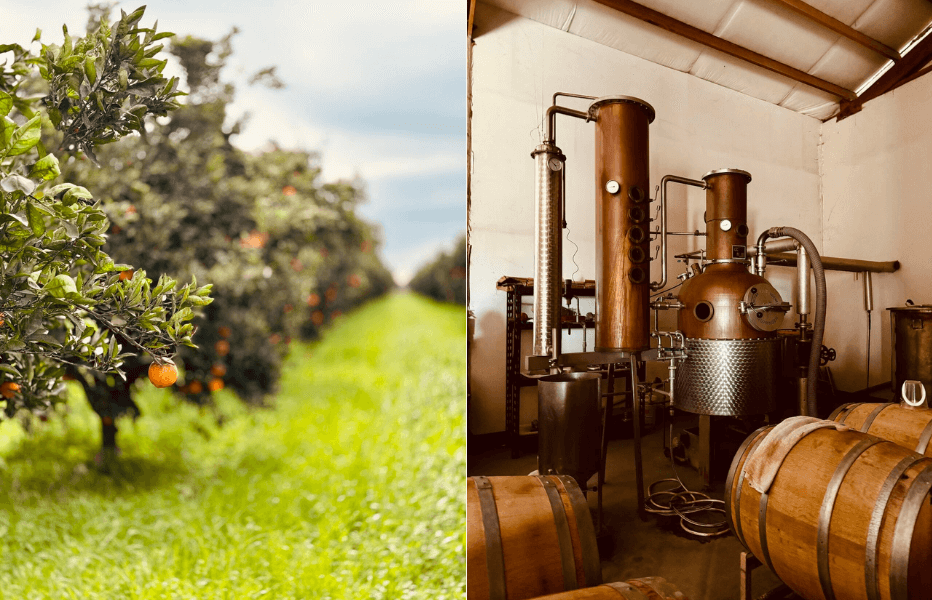
Image: Marian Farm and Distillery, CA.
Currently, our big focus is on getting exposure, and more importantly getting our product into customers' hands throughout the UK, whether it's being able to order at a bar or purchase it in-store. It’s not a matter of needing to make a better gin at the moment, but creating the awareness, the presence, and becoming a go-to gin for people.
Again, being self-funded means we need to focus our dollars (pounds) on where they can be most effective, and sometimes that means holding off on some opportunities until we have more funds to invest. Since we are only 18 months in we are still at the point where costs far outweigh income.
Long-term, of course, we would love to get to a point where we can invest more in marketing, branding, and product development. I don’t think we need to have a dozen types of Ginagain (don’t expect a Ginagain 12), but rather we want to make Ginagain a solid product with a solid brand and solid consumer base. We don’t need to be the next big gin, but we would take it if it came to that.
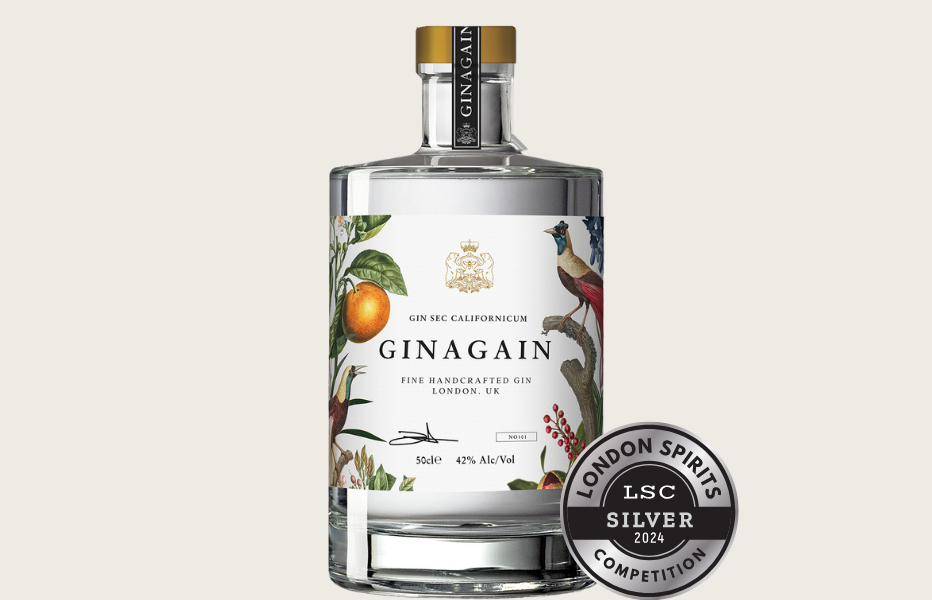
Image: 2024 London Spirits Competition Winner - Ginagain
Rick Allen’s Ginagain is a distillation of botanicals and a tribute to the fields of California’s Central Valley, a place where citrus orchards thrive under the hot sun. By bringing that Californian spirit into the UK’s rich gin culture, Allen has created something refreshingly distinct. As Ginagain evolves, so too does the balance between its West Coast origins and its British production, offering a taste of sunshine with every sip. With both passion and patience, Allen’s journey reminds us that the best craft spirits come from a blend of deep roots, daring creativity, and an unwavering commitment to quality.
In conversation with Malvika Patel, Editor and VP, Beverage Trade Network
Also Read:
Gin Trends for Bartenders in 2024-25: Insights from the 2024 London Spirits Competition
Clarity Gin Wins Gold and Best in Show at 2024 London Spirits Competition
Scotland’s Gin Tale: Martin Reid’s Journey with The Gin Cooperative
Make your spirits stand out on the world stage. Enter the London Spirits Competition by 30 November 2025 to secure Early Bird savings.